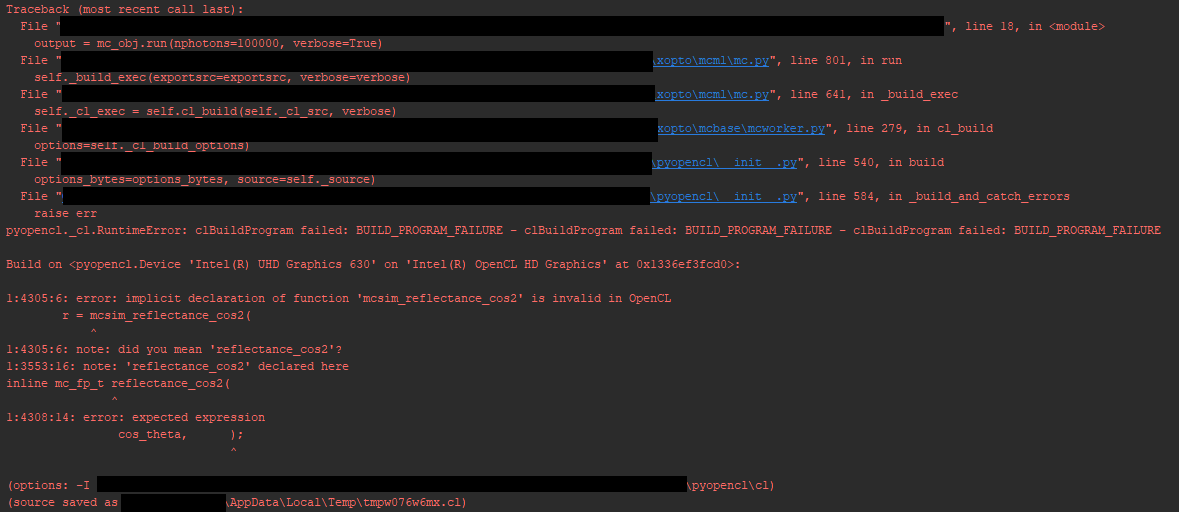Seems that the code of the rectangular source was not updated to reflect the common type definitions. There were also a couple of typos in the OpenCL & Python source. I am attaching a modified source file of the rectangular source along with an example. Let me know if there are further issues with the source. The bug will be fixed with the next commit.


Hi,
I am trying to perform a simple Monte Carlo simulation with rectangular light source and detector. I built the MC object as follows: `from xopto.mcml import mc from xopto.cl import clinfo
cl_device = clinfo.gpu() layers = mc.mclayer.Layers([mc.mclayer.Layer(d=0.0, n=1.0, mua=0.0, mus=0.0, pf=mc.mcpf.Hg(1)), # Surrounding medium mc.mclayer.Layer(d=2.0e-3, n=1.34, mua=0.2e+3, mus=(3/(1-0.9))*1e+3, pf=mc.mcpf.Hg(0.9)), # tissue mc.mclayer.Layer(d=0.0, n=1.0, mua=0.0, mus=0.0, pf=mc.mcpf.Hg(1))]) # Surrounding medium filter = mc.mctrace.Trace(maxlen=250, options=mc.mctrace.Trace.TRACE_ALL, plon=True) fluence = mc.mcfluence.Fluence(xaxis=mc.mcfluence.Axis(-5e-3, 5e-3, 500), yaxis=mc.mcfluence.Axis(-5e-3, 5e-3, 500), zaxis=mc.mcfluence.Axis(0, 2e-3, int(2.0e-3/2e-5))) detector = mc.mcdetector.Detectors(top=mc.mcdetector.Cartesian(xaxis=mc.mcdetector.Axis(-4.5e-3, -4e-3, 1), yaxis=mc.mcdetector.Axis(-3.5e-3, -3e-3, 1), direction=(0.0, 0.0, 1.0))) light_source = mc.mcsource.LambertianRectangular(position=(-0.5e-3,-0.2e-3, 0), width=0.3e-3, height=0.3e-3, n=1.5, na=0.9) mc_obj = mc.Mc(layers=layers, trace=filter, fluence=fluence, source=light_source, detectors=detector, cl_devices=cl_device)
output = mc_obj.run(nphotons=100000, verbose=True)`
When I try to run the simulation, I receive the following error:
I traced the error and realized there was a typo! Instead of "Structure", "Stucture" was used. I fixed the typo in the code and tried to re-perform the simulation. I received another error as follows:
When I traced the source of error again, I came to this part of the LambertianRectangular class definition code: `class LambertianRectangular(UniformRectangular): @staticmethod def cl_type(mc: mcobject.McObject) -> cltypes.Structure: T = mc.types class ClLambertianRectangular(cltypes.Structure): ''' Structure that is passed to the Monte carlo simulator kernel.
When I compared it with the Fiber class code, I realized in the cl_type function, the input types are different. The same can be observed if you compare the input types declared in the cl_type function with those in the cl_declaration function -> "join" segment. So I tried to adjust the input types of cl_type function according to those specified in the cl_declaration function. I performed the simulation and received the following error.
I would say similar thing must happen for other classes of rectangular sources; however, I didn't check all of them except the UniformRectangular class. I would appreciate it if you could please let me know how I can fix this issue.